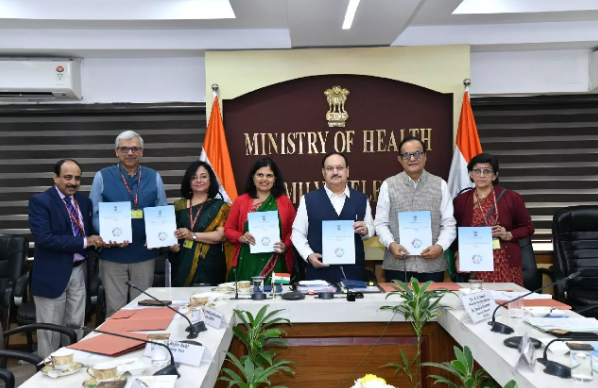SYLLABUS
GS-2: Issues relating to development and management of Social Sector/Services relating to Health, Education, Human Resources.
Context: Recently, Union Minister of Health and Family Welfare launched the second version of the National Action Plan on Antimicrobial Resistance (2025–29).
Key Highlights of NAP – AMR 2.0
- It addresses the gaps identified in the first NAP-AMR by increasing the ownership of AMR-related efforts, strengthening inter-sectoral coordination and ensuring stronger engagement with the private sector.
- The NAP-AMR 2.0 was released on the first day of the WHO’s World AMR Awareness Week (18-24 Nov).
- The updated NAP-AMR includes specific action plans of each key stakeholder ministry/department, along with budget, coordination and collaboration mechanisms among sectors.
- Emphasis was given to increased education, awareness and training on AMR, the need for enhanced laboratory capacity, and infection control in healthcare settings.
About Anti-Microbial Resistance (AMR)
- AMR refers to the ability of microorganisms like bacteria, viruses, fungi, and parasites to develop mechanisms that enable them to survive exposure to antimicrobial medicines designed to kill or inhibit them.
- This makes infections harder to treat, leading to increased illness and death, and threatens modern medical practices.
- AMR is a global threat that spreads through overuse and misuse of antimicrobials in humans, animals, and agriculture, impacting human health, food security, and economic well-being.
- AMR is often referred to as a “silent pandemic,” with estimates projecting millions of deaths annually by 2050 if unchecked.
Challenges associated with the AMR
- Irrational Antibiotic Use: Widespread overuse, misuse, and self-medication with antibiotics in human health, livestock, aquaculture, and crop production accelerates resistance development.
- Low Awareness and Training: Inadequate public awareness and limited training for healthcare professionals.
- Weak Surveillance Systems: India’s AMR surveillance remains constrained by insufficient laboratory infrastructure, and a lack of standardised reporting, leading to data gaps and delayed responses.
- Regulatory Gaps: Enforcement of regulations on antibiotic sales, prescription-only rules, pharmaceutical waste discharge, and antimicrobial use in animals is weak, enabling easy over-the-counter access and unregulated usage.
Government Initiatives to eradicate AMR
- National Action Plan for AMR (2017): India’s first National Action Plan for AMR was launched in April 2017 by the Union Ministry of Health and Family Welfare. It focuses on raising awareness, strengthening surveillance, advancing research, and enhancing infection prevention and control.
- Antibiotic Stewardship Program (ASP): An antibiotic stewardship program (ASP) is a coordinated effort to promote the appropriate use of antibiotics to improve patient outcomes, reduce the spread of antimicrobial resistance, and decrease infections.
- One Health Approach: It is an integrated strategy that recognizes the interconnectedness of human, animal, and environmental health to promote well-being and address global health challenges like zoonotic diseases, antimicrobial resistance, and climate change.
- Delhi Declaration on AMR (2016): The Delhi Declaration pledges a holistic approach to AMR, recognizes its serious concern, and recommends a National Authority for Containment of AMR.
Way Ahead
- Research & Data Sharing: Increase investments in AMR research and encourage cross-country data exchange to guide policy and interventions.
- Better Sanitation and Hygiene: Improve access to clean water, sanitation, and hygiene (WASH) infrastructure in communities and health facilities to limit infection spread.
- Strengthen Primary Healthcare: Enhance primary care services to enable early diagnosis and timely treatment, reducing progression to severe, drug-resistant infections.
- Public Education: Conduct targeted campaigns to clarify that antibiotics treat bacterial—not viral—infections, preventing misuse.

